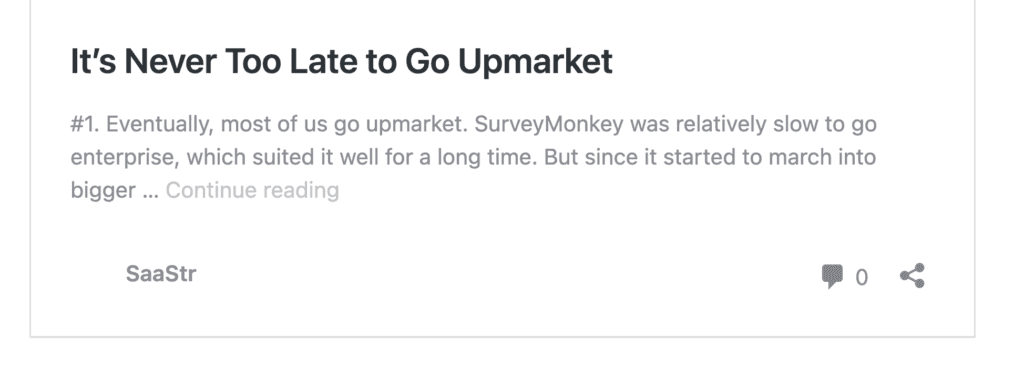#1. Eventually, most of us go upmarket.
SurveyMonkey was relatively slow to go enterprise, which suited it well for a long time.
But since it started to march into bigger deals more recently, growth >re-accelerated< … from 17% at IPO to 20% today pic.twitter.com/pZKC8xMCGt
— Jason
BeKind
Lemkin (@jasonlk) January 10, 2021
When you’re starting off in SaaS, it’s very tempting to target small businesses. After all, when you launch, your product will be pretty feature-poor. You won’t have the resources to service the Fortune 500. And in fact, unless you’ve worked and lived inside the Fortune 500, you won’t understand them at all. How they buy, when they buy, why they buy. And why would some Fortune 500 company buy your little MSP (Minimum Sellable Product) product run by a team of 8 guys in a one-room office? It sounds nuts.
But it will probably happen. Calendly for example waited until about $50m ARR to build out an enteprise sales team. That journey here:
Most of us don’t stay SMB forever.
A few other examples:
- Slack started off almost 100% self-serve with no sales reps, but at $1B was 50% enterprise. More here.
- Zoom similarly started off almost 100% self-serve and SMB, and then later added an enterprise team. Today, 63% of the revenue is 10+ seat deals, and they have 2,000 Enterprise customers. More here.
- PagerDuty was almost entirely SMB at IPO, at $125m in ARR. But at $250m ARR, it’s $1m+ customers are its fastest growing segment! More here.
Here’s why it usually happens. If your product is really only applicable for SMBs, or techies, then that’s where it will stay. But if you are solving a problem universal to all-sized companies, if you get some traction with SMBs, with anyone … that means you’ve solved a least a little piece of a real business problem pretty well. And that means, eventually and maybe even pretty soon, the enterprise customers will find you. Perhaps not on Day 1. And most likely, almost certainly at first, just a division, a group inside of a F500 to start. Because the more agile parts, divisions, groups of Fortune 500 companies act a lot like SMBs sometimes. They need to make quick decisions just for their group, their division, to get things done.
But if you solve a universal problem for a Company of 10 people, or 100 people … there’s a good chance you might solve it for a company of 10,000 employees as well.
The first time you get a few in-bound leads from true large enterprises, you may be confused. You may even be overwhelmed, because they’ll quickly identify all your huge feature holes and push you to fill them faster and in a different order and manner than you were expecting.
But my advice is, consider it. Consider taking those first few large enterprise customers, even if you seem ill-suited to them at the time. If you can get huge on SMBs alone, that’s great. But most SaaS companies get there with companies of all sizes — including the true, big large, scary enterprise.
And if you can start at the bottom, with a product elegant enough to actually work for small businesses — who don’t have time for training, or non-intuitive software. And then grow up market … then you can have something that really changes how the enterprise uses software. Then, you’ll be doing something really special.
A bit more here:
(note: an updated SaaStr Classic post)
The post Why There Is a 50/50 Chance You’ll Tilt Upmarket in SaaS appeared first on SaaStr.
via https://www.aiupnow.com
Jason Lemkin, Khareem Sudlow

